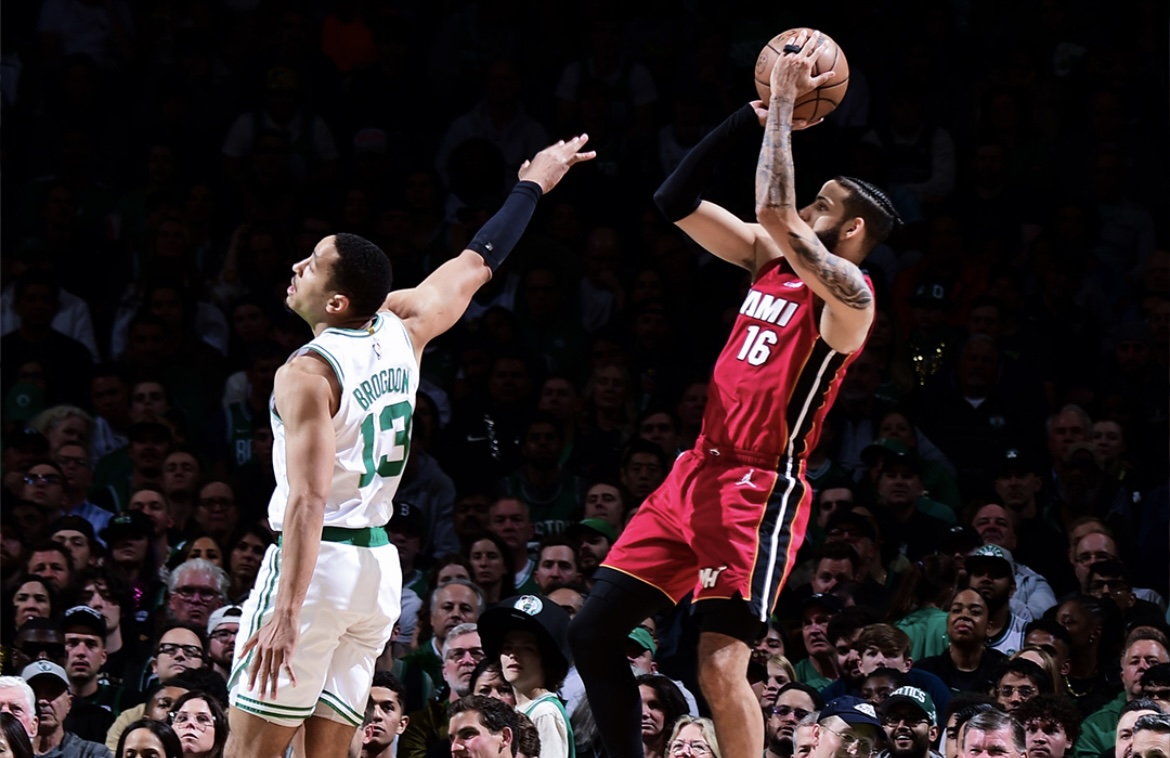Five Takeaways from Heat’s Win Over Celtics in Game 2
The Miami Heat walk into game 2 in TD Garden, and steal yet another one.
Grant Williams pokes the bear, in Jimmy Butler, and it all went downhill from there.
Heat up 2-0.
My takeaways:
#1: Caleb Martin continues his “close-out reading masterclass” in that first half.
I went into it deeply after game 1 of the Eastern Conference Finals, but the role of Caleb Martin has been cut to as simple as can be. When Butler and Adebayo get doubled, be ready to pull as you are the guy they will help off of. If there’s a strong close-out, make the read and utilize your rim pressure. He’s been doing both at an incredibly high level. Looking at the first half of this game, the offense for the Heat was far from pretty, yet Martin actually stabilized it in that second quarter. Celtics give their big punch, and Martin starts getting comfortable: baseline jumper, spot-up, pump-fake and lay-in. Rinse and repeat. Let me just say, once he hits one early like he did tonight, he has you right where he wants you. He can play to his two biggest strengths against a close-out: his quick first step and attacking the high foot of his defender.
#2: Early offense: Duncan Robinson’s movement and cutting.
When dissecting some of the outer areas of the Heat’s first half, Duncan Robinson was a big part of it. The minutes distribution for Robinson and Max Strus was much different than usual, as each shooter essentially had their own quarter. Strus had a good start, but Robinson made an impact in a very unconventional way. For the first 3 minutes or so, he only had 1 field goal attempt and no actions were being run for him. On the film side, the matchup isn’t the greatest for him with the way they can flatten him with switches. So on those expected switches, he started playing the back slots with slick cuts and quick decisions. Bam Adebayo found him multiple times in that range, as the defender who is top locking his incoming hand-off, now tries to recover on his back with a layup on the way. That’s when the handoffs and pick and rolls began to work. Sometimes it’s not an adjustment, it’s just shifting a defender around a bit. Robinson did that in the second quarter.
#3: Taming the turnovers and pace watch.
I’ve heard some conversations on the national stage hinting at Miami’s game 1 win having a lot to do with pace. That could partly be true, but we also can’t mix up fast pace with early clock shots. We saw more of the latter with Miami in these playoffs, but I’m not so sure the formal consistently fits them. For example, when Boston made that second quarter 19-2 run, my main takeaway from a Heat perspective was that Kyle Lowry needed to settle them. The Celtics buckets were feeding off the crowd, running the break, and waiting for unfortunate Miami turnovers. Butler ended up coming in early, the game was slowed down, and the Heat gained back control. Pace can be increased for the obvious reasons like 2-on-1’s, Butler, Martin, or Bam using their athleticism, or Love full court dimes, but this series feels to be much more reliant on playing in the half-court and out of the Celtics game. Also the reason I said Lowry was my series X-Factor. Not just due to the scoring openings from game 1, but for the traditional point guard play.
#4: Jayson Tatum finding his 1-on-1 rhythm, so what does Miami do next?
Pretty much when Jayson Tatum had the ball in his hands, good shots were the result as he found a major isolation rhythm on both his attacks and swift step backs. As for the stretches where he slots off the ball, you could tell that Miami loves it. No more movement while the Heat can mix up more changes in their usual coverages. But as on-ball Tatum made a more frequent appearance, what do the Heat do next? Either allow him to cook and cut off the other outlets, which I never enjoy, or find a counter to throw things out of rhythm. Sort of like the way they went at Jalen Brunson, except it’s a dangerous game to play with the major difference between the Knicks and Celtics when comparing the rest of the roster. Rely on rotations and try to get the ball out of Tatum’s hands early would be a good idea, especially since if he falls in love with tough shots from deep, you live with it. Defensive adjustments are coming, since game 3 is usually when we see the biggest shift for Spoelstra.
#5: Down the stretch…
As the Celtics held a double digit lead throughout the starts of the fourth, Caleb Martin kept doing his thing: any time Boston made a run, he would swing things right back. The other guy I discussed in this piece, Duncan Robinson, held things down before Butler re-entered in the fourth. A couple of threes put Miami in a much more comfortable situation. 6 point game, 7:40 to go. Jimmy Butler and Grant Williams get into it following a Butler and-1, which felt like an interesting choice. Butler isn’t afraid to talk when he’s down. Next possession down, Butler takes Williams to the cup, easy floater. The Heat also kept leaning into their 3 man actions with Adebayo at the helm. Adebayo’s high assist number in game 2 would tell you that alone, but they kept getting great looks out of a simply back-screen or pindown for either a lay-in or three. The late game offense then turned into Jimmy Butler taking Williams one-on-one like clockwork, back to back possessions and the Heat are up 2. Under a minute to go in a 3 point game, Adebayo gets an offensive rebound for a putback to put the lead at 5. Tatum gets fouled on a three on the other end immediately after, dropping the deficit right back. So who does Miami put the ball in the hands of with the game on the line? Butler, right? Wrong, Vincent holds it, flows into a step back for the most important bucket of the night. A couple free throws later, the Heat take a 2-0 lead…









The way you’re quick to drop analysis after the game is superb. Duncan and Martin were huge in this game and I’m a super fan of the way you’re able to break down how Miami is able to dissect a top 5 defense in the post season